mTORC2 protein complex-mediated Akt (Protein Kinase B) Serine 473 Phosphorylation is not required for Akt1 activity in human platelets [corrected]
- PMID: 21592956
- PMCID: PMC3137030
- DOI: 10.1074/jbc.M110.202341
mTORC2 protein complex-mediated Akt (Protein Kinase B) Serine 473 Phosphorylation is not required for Akt1 activity in human platelets [corrected]
Erratum in
- J Biol Chem. 2011 Sep 2;286(35):31062
Abstract
Protein kinase B (PKB, Akt) is a Ser/Thr kinase involved in the regulation of cell survival, proliferation, and metabolism and is activated by dual phosphorylation on Thr(308) in the activation loop and Ser(473) in the hydrophobic motif. It plays a contributory role to platelet function, although little is known about its regulation. In this study, we investigated the role of the mammalian target of rapamycin complex (mTORC)-2 in Akt regulation using the recently identified small molecule ATP competitive mTOR inhibitors PP242 and Torin1. Both PP242 and Torin1 blocked thrombin and insulin-like growth factor 1-mediated Akt Ser(473) phosphorylation with an IC(50) between 1 and 5 nm, whereas the mTORC1 inhibitor rapamycin had no effect. Interestingly, PP242 and Torin1 had no effect on Akt Thr(308) phosphorylation, Akt1 activity, and phosphorylation of the Akt substrate glycogen synthase kinase 3β, indicating that Ser(473) phosphorylation is not necessary for Thr(308) phosphorylation and maximal Akt1 activity. In contrast, Akt2 activity was significantly reduced, concurrent with inhibition of PRAS40 phosphorylation, in the presence of PP242 and Torin1. Other signaling pathways, including phospholipase C/PKC and the MAPK pathway, were unaffected by PP242 and Torin1. Together, these results demonstrate that mTORC2 is the kinase that phosphorylates Akt Ser(473) in human platelets but that this phosphorylation is dispensable for Thr(308) phosphorylation and Akt1 activity.
Figures
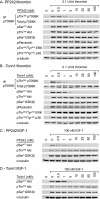
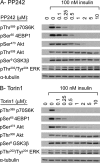
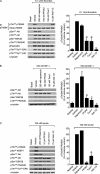
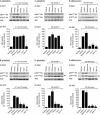
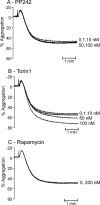
Similar articles
-
Mechanical regulation of glycogen synthase kinase 3β (GSK3β) in mesenchymal stem cells is dependent on Akt protein serine 473 phosphorylation via mTORC2 protein.J Biol Chem. 2011 Nov 11;286(45):39450-6. doi: 10.1074/jbc.M111.265330. Epub 2011 Sep 28. J Biol Chem. 2011. PMID: 21956113 Free PMC article.
-
Protein kinase C and P2Y12 take center stage in thrombin-mediated activation of mammalian target of rapamycin complex 1 in human platelets.J Thromb Haemost. 2014 May;12(5):748-60. doi: 10.1111/jth.12552. J Thromb Haemost. 2014. PMID: 24612393 Free PMC article.
-
Dual regulation of glycogen synthase kinase 3 (GSK3)α/β by protein kinase C (PKC)α and Akt promotes thrombin-mediated integrin αIIbβ3 activation and granule secretion in platelets.J Biol Chem. 2013 Feb 8;288(6):3918-28. doi: 10.1074/jbc.M112.429936. Epub 2012 Dec 13. J Biol Chem. 2013. PMID: 23239877 Free PMC article.
-
NFluc-FHA2-Aktpep-CFluc.2008 Nov 14 [updated 2008 Dec 22]. In: Molecular Imaging and Contrast Agent Database (MICAD) [Internet]. Bethesda (MD): National Center for Biotechnology Information (US); 2004–2013. 2008 Nov 14 [updated 2008 Dec 22]. In: Molecular Imaging and Contrast Agent Database (MICAD) [Internet]. Bethesda (MD): National Center for Biotechnology Information (US); 2004–2013. PMID: 20641681 Free Books & Documents. Review.
-
Disentangling the signaling pathways of mTOR complexes, mTORC1 and mTORC2, as a therapeutic target in glioblastoma.Adv Biol Regul. 2022 Jan;83:100854. doi: 10.1016/j.jbior.2021.100854. Epub 2021 Dec 6. Adv Biol Regul. 2022. PMID: 34996736 Review.
Cited by
-
Rapamycin Inhibition of mTOR Reduces Levels of the Na+/H+ Exchanger 3 in Intestines of Mice and Humans, Leading to Diarrhea.Gastroenterology. 2015 Jul;149(1):151-62. doi: 10.1053/j.gastro.2015.03.046. Epub 2015 Mar 30. Gastroenterology. 2015. PMID: 25836987 Free PMC article.
-
Serine 474 phosphorylation is essential for maximal Akt2 kinase activity in adipocytes.J Biol Chem. 2019 Nov 8;294(45):16729-16739. doi: 10.1074/jbc.RA119.010036. Epub 2019 Sep 22. J Biol Chem. 2019. PMID: 31548312 Free PMC article.
-
Periostin responds to mechanical stress and tension by activating the MTOR signaling pathway.PLoS One. 2013 Dec 13;8(12):e83580. doi: 10.1371/journal.pone.0083580. eCollection 2013. PLoS One. 2013. PMID: 24349533 Free PMC article.
-
AKT and DUBs: a bidirectional relationship.Cell Mol Biol Lett. 2025 Jul 7;30(1):77. doi: 10.1186/s11658-025-00753-3. Cell Mol Biol Lett. 2025. PMID: 40624457 Free PMC article. Review.
-
Modulation of platelet activation and thrombus formation using a pan-PI3K inhibitor S14161.PLoS One. 2014 Aug 12;9(8):e102394. doi: 10.1371/journal.pone.0102394. eCollection 2014. PLoS One. 2014. PMID: 25115838 Free PMC article.
References
Publication types
MeSH terms
Substances
Grants and funding
- PG/08/056/25325/BHF_/British Heart Foundation/United Kingdom
- PG/10/100/28658/BHF_/British Heart Foundation/United Kingdom
- FS/12/3/29232/BHF_/British Heart Foundation/United Kingdom
- FS/05/047/18875/BHF_/British Heart Foundation/United Kingdom
- PG/08/113/25515/BHF_/British Heart Foundation/United Kingdom
LinkOut - more resources
Full Text Sources
Molecular Biology Databases
Miscellaneous

